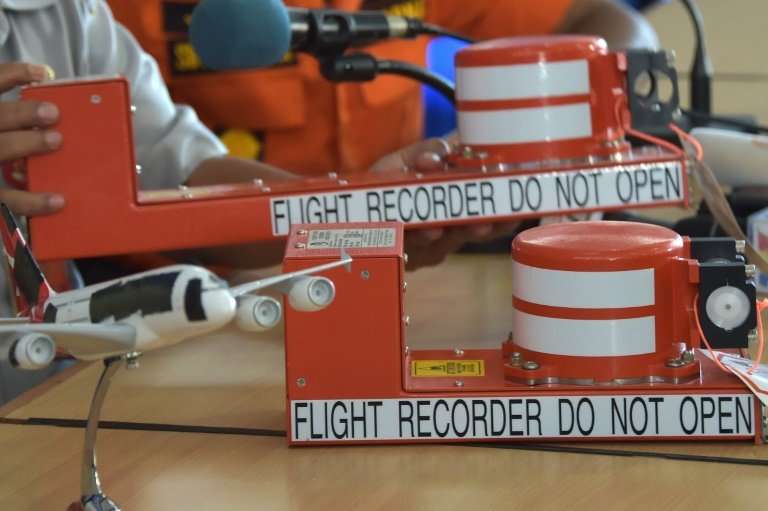Despite the name, the two boxes—consisting of the flight data recorder and the cockpit voice recorder—are in fact bright orange
When investigators arrive at an aviation crash site, one of their first priorities is to locate the plane's black boxes, two pieces of equipment that can hold vital clues on what caused an aircraft to go down.
On Wednesday, Indonesian authorities were confident that sonar technology had pinpointed the location of the downed Lion Air jet, after two days of searching for the wreckage and its crucial data.
There were 189 people on board flight JT610—a Boeing 737-MAX, one of the world's newest and most advanced commercial passenger jet models.
Lion's admission that the plane had an unspecified technical issue on a previous flight—as well as the plane's abrupt nosedive just 12 minutes after takeoff—have raised questions about whether it had any faults specific to the newly released model.
Retrieving the black box will be key. The treasure trove of information they provide helps explain nearly 90 percent of all crashes, according to aviation experts.
Despite the name, the two boxes—consisting of the flight data recorder and the cockpit voice recorder—are in fact bright orange with reflective stripes, and all commercial planes are obliged to have them on board.
The digital flight data recorder gathers information about the speed, altitude and direction of the plane with enough storage for 25 hours of data, while the cockpit voice recorder keeps track of conversations and other sounds in the pilots' cabin.
Analysing the data can take "days or even weeks" depending on what state the boxes are in, according to an expert who worked on the 2004 investigation of a Boeing 737 that plunged into the Red Sea after taking off from Sharm el-Sheikh, with the loss of all 148 lives on board.
However, the findings are often not released publicly until all of the information has been examined in detail.
Black boxes past and future
Introduced in the 1960s, flight recording devices are housed in boxes built to survive extreme shocks, fire and lengthy submersion underwater.
They each weigh seven to 10 kilograms (15 to 22 pounds) and can survive as deep as 6,000 metres (almost 20,000 feet) underwater or an hour at 1,100 degrees Celsius (2,012 degrees Fahrenheit). To make them easier to find, they are fitted with a beacon which can emit a signal for one month.
In January 2004, the black boxes of the Egyptian charter flight that crashed off the coast of Sharm el-Sheikh were found after a two-week search, 1,022 metres below water.
In 2011, after 23 months submerged at a depth of 3,900 metres in the Atlantic Ocean, the black boxes of doomed Air France flight AF447 travelling between Rio and Paris were retrieved, with the data intact, allowing investigators to determine the causes of the June 1, 2009 crash.
Flight JT610 came down in water some 30-40 metres deep which should make the task of recovering the black boxes significantly easier for Indonesian investigators.
Long-haul Airbus A350 and A380 passengers jets will soon come equipped with ejectable black boxes that can float, making them easier to find in an air crash at sea.
© 2018 AFP
























